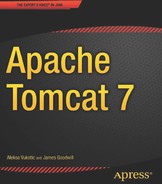Preface
The first edition of this book covered the then-new Jakarta Tomcat 4. Tomcat has come a long way from there, becoming Apache Tomcat in the process, with version 7 released in January 2011. During this time, Tomcat has become the most popular and used Java servlet container on the market. Other open source application servers also have started using Tomcat as their embedded servlet engine. With the shift of focus in enterprise Java development toward more lightweight architecture and tools, Tomcat has grown to become the deployment platform of choice for business-critical enterprise Java applications.
This edition has been revised to cover the latest features of Apache Tomcat 7 and Servlet API 3.0. In the world of technology, changes are introduced quickly, and yesterday’s new ideas are the legacy systems of tomorrow. Although Tomcat is still a leading open source servlet container, a lot has changed in Java web technologies since version 4. The biggest change was Java Servlet specification, which advanced to version 3.0, bringing a lot of new features along the way.
This book is based on the original text by James Goodwill, and the concepts and structure of the original book have been kept where possible. However, where the changes to Tomcat architecture and Java Servlet specification have been too great, the text was changed significantly, and some chapters have been entirely rewritten. In addition, some of the chapters from the original book have been removed, because they are now outdated. Instead, new chapters, covering up-to-date Tomcat concepts and Java web technologies, have been included. All code and configuration examples have been either updated to use up-to-date Tomcat 7 and Servlet API 3 syntax and structure, or have been entirely replaced to match the architectural changes to the underlying technology.
This book will be useful to the reader who is familiar with Java, but new to servlet development with Tomcat. That’s why it contains an introduction to the development of Java web applications using servlets and JSPs. Server administrators new to Tomcat 7 also will find a lot of useful information in this book related to Tomcat management and configuration tasks.
It was not the aim of the authors to provide a detailed Tomcat reference covering all aspects of Tomcat configuration. The authors did try to write a book that introduces Tomcat in the context of web application development, so that readers can implement, deploy, and manage their Java web applications using Apache Tomcat 7 server. This is a practical guide to Apache Tomcat, with a lot of real-world examples and solutions to common problems in web application development and deployment. We hope you will find this book useful in your day-to-day experience with Tomcat—that would mean it has served its purpose.
